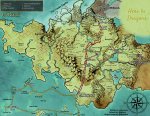It looks like Amazon has leaked the title and description of the new D&D book a day early (unless it's all a fake-out by WotC) -- and it's a new D&D setting book called The Explorer's Guide to Wildemount; it's the Critical Role campaign setting, penned by Matt Mercer!
There's no cover image yet, so we're stuck with the "Coming Soon" image.
This book appeared without a title on Amazon last week, and a 'reveal' date of January 9th, which was then later delayed until January 13th. Amazon appears to have jumped the gun a day early.
Here's some information about Wildemount, which is a continent in the same world as Critical Role's other setting, Tal'Dorei. It is described by the official wiki has having "real-world Eastern European influence.... The Dwendalian Empire takes inspiration from 15th century Russia as well as Germanic nations in Central Europe (e.g., Prussia). Xhorhas has a more 13th-century Romanian flair. Outside of Wynandir, on the edges of the Dwendalian Empire, the cultures and peoples of those regions display a distinctly 14th-century Spanish flavor."
HOW DO YOU WANT TO DO THIS?
A war brews on a continent that has withstood more than its fair share of conflict. The Dwendalian Empire and the Kryn Dynasty are carving up the lands around them, and only the greatest heroes would dare stand between them. Somewhere in the far corners of this war-torn landscape are secrets that could end this conflict and usher in a new age of peace—or burn the world to a cinder.
Create a band of heroes and embark on a journey across the continent of Wildemount, the setting for Campaign 2 of the hit Dungeons & Dragons series Critical Role. Within this book, you’ll find new character options, a heroic chronicle to help you craft your character’s backstory, four different starting adventures, and everything a Dungeon Master needs to breathe life into a Wildemount-based D&D campaign…
Critical Role's other setting, Tal'Dorei, was published a couple of years ago by Green Ronin. This brings the list of settings in official D&D books to five: Forgotten Realms, Ravnica, Ravenloft, Eberron, and Wildemount.
UPDATE! Barnes & Noble has the cover (but not the title or description).

There's no cover image yet, so we're stuck with the "Coming Soon" image.
This book appeared without a title on Amazon last week, and a 'reveal' date of January 9th, which was then later delayed until January 13th. Amazon appears to have jumped the gun a day early.
Here's some information about Wildemount, which is a continent in the same world as Critical Role's other setting, Tal'Dorei. It is described by the official wiki has having "real-world Eastern European influence.... The Dwendalian Empire takes inspiration from 15th century Russia as well as Germanic nations in Central Europe (e.g., Prussia). Xhorhas has a more 13th-century Romanian flair. Outside of Wynandir, on the edges of the Dwendalian Empire, the cultures and peoples of those regions display a distinctly 14th-century Spanish flavor."
HOW DO YOU WANT TO DO THIS?
A war brews on a continent that has withstood more than its fair share of conflict. The Dwendalian Empire and the Kryn Dynasty are carving up the lands around them, and only the greatest heroes would dare stand between them. Somewhere in the far corners of this war-torn landscape are secrets that could end this conflict and usher in a new age of peace—or burn the world to a cinder.
Create a band of heroes and embark on a journey across the continent of Wildemount, the setting for Campaign 2 of the hit Dungeons & Dragons series Critical Role. Within this book, you’ll find new character options, a heroic chronicle to help you craft your character’s backstory, four different starting adventures, and everything a Dungeon Master needs to breathe life into a Wildemount-based D&D campaign…
- Delve through the first Dungeons & Dragons book to let players experience the game as played within the world of Critical Role, the world’s most popular livestreaming D&D show.
- Uncover a trove of options usable in any D&D game, featuring subclasses, spells, magic items, monsters, and more, rooted in the adventures of Exandria—such as Vestiges of Divergence and the possibility manipulating magic of Dunamancy.
- Start a Dungeons & Dragons campaign in any of Wildemount’s regions using a variety of introductory adventures, dozens of regional plot seeds, and the heroic chronicle system—a way to create character backstories rooted in Wildemount.
Critical Role's other setting, Tal'Dorei, was published a couple of years ago by Green Ronin. This brings the list of settings in official D&D books to five: Forgotten Realms, Ravnica, Ravenloft, Eberron, and Wildemount.
UPDATE! Barnes & Noble has the cover (but not the title or description).





